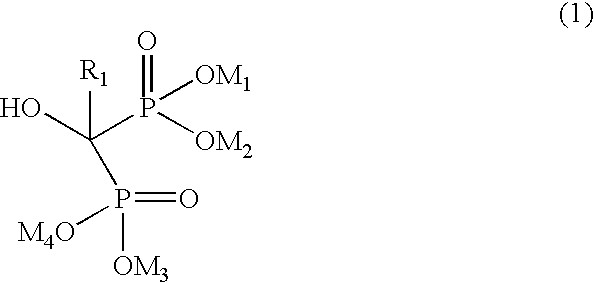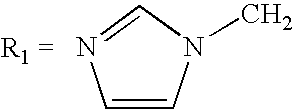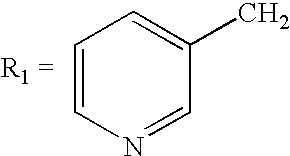Preparation of biphosphonic acids and salts thereof
a technology of biphosphonic acid and salt, which is applied in the field of preparation of bisphosphonic acid and its pharmacologically active salt, can solve the problems of difficult elimination of solvents from the finished product, high cost of solvents, and difficult industrial synthesis of these substances
- Summary
- Abstract
- Description
- Claims
- Application Information
AI Technical Summary
Benefits of technology
Problems solved by technology
Method used
Image
Examples
example 1a
Formation of the Reaction Solvent (Tributylammonium Chloride)
[0026]A 3-litre reactor provided with a Dean-Stark trap and drip funnel is charged with 150 ml of toluene and 334.3 g of tributylamine. The solution is cooled to 25-30° C. and from the drip funnel there are added 152.6 ml of 33% aqueous hydrochloric acid, in the meantime controlling that the temperature does not exceed 40° C. The homogeneous solution thus obtained is then distilled in vacuum conditions (50 mmHg) until the internal temperature reaches 80° C. and no more liquid is distilled from the reactor. The mixture thus obtained consists of tributylammonium chloride and is ready for use in the subsequent reactions of formation of bisphosphonic acids.
example 1b
Preparation of Sodium Alendronate
[0027]To the liquid phase obtained in Example 1, kept at 70° C., there are added 79.5 g of phosphorous acid and subsequently 100 g of γ-aminobutyric acid. The temperature of the mixture is brought to 60° C., and from the drip funnel there are added 266.4 g of phosphorus trichloride during an interval of approximately one hour, maintaining the internal temperature between 60° C. and 65° C. Subsequently, the reaction mixture is kept under stirring for two hours at 60° C., and then is cooled to 20° C. There are added 410 ml of deionized water, keeping the temperature of the reaction mixture below 40° C. At the end of addition, the temperature is brought up to 90° C. and kept in these conditions for 2 hours. After cooling to 10° C., 1093 ml of 30% aqueous sodium hydroxide are added to the reaction mixture, until the final pH is 11-12. The resulting top layer, consisting of tributylamine is separated off. The tributylamine may be subsequently treated with...
example 2
Preparation of Zoledronic Acid
[0030]20 of tributylammonium chloride, prepared as in Example 1A, are put into a 100-ml flask provided with coolant, magnetic stirrer, drip funnel and thermometer. The solid is melted at 60° C., then 3.2 g of phosphorous acid and 5.0 g of 2-(1-imidazyl)-acetic acid are added. The temperature of the mixture is then brought up to 65-70° C., and from the drip funnel there are slowly added 10.9 g of PCl3. Once the addition is completed, the mixture is brought up to 80° C. and kept under these conditions for two hours, at the end of which 20 ml of deionized water are added. The mixture is brought to 90° C. and is kept under these conditions for 2 hours. It is then cooled down to room temperature, and 50 ml of 33% NaOH are added to the mixture, until a pH of the mixture ≧12 is reached. The two phases that have formed are separated, and 20 ml of toluene are added to the aqueous bottom phase, stirring the mixture for 15 min. The phases are once more separated, ...
PUM
| Property | Measurement | Unit |
|---|---|---|
| temperature | aaaaa | aaaaa |
| temperature | aaaaa | aaaaa |
| temperature | aaaaa | aaaaa |
Abstract
Description
Claims
Application Information
 Login to View More
Login to View More - R&D
- Intellectual Property
- Life Sciences
- Materials
- Tech Scout
- Unparalleled Data Quality
- Higher Quality Content
- 60% Fewer Hallucinations
Browse by: Latest US Patents, China's latest patents, Technical Efficacy Thesaurus, Application Domain, Technology Topic, Popular Technical Reports.
© 2025 PatSnap. All rights reserved.Legal|Privacy policy|Modern Slavery Act Transparency Statement|Sitemap|About US| Contact US: help@patsnap.com



